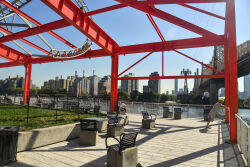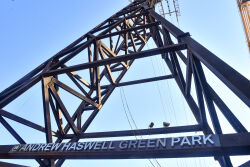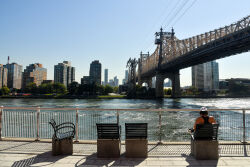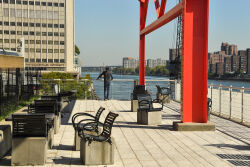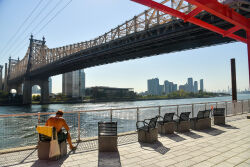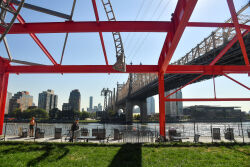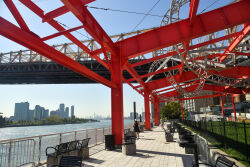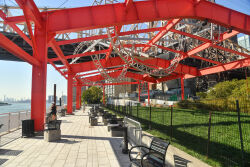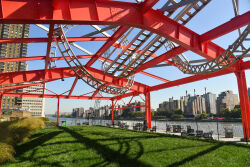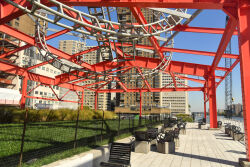Andrew Haswell Green Park
East River Roundabout
This 80-foot long aluminum helix is by artist Alice Aycock (b.1946). Dedicated on November 6, 1995, the highly visible and significant sculpture is attached to the skeletal steel roof supports of a former waterfront garbage transfer station.
Aycock was selected to create this sculpture as part of a project to transform the roof of the defunct Department of Sanitation facility into a public plaza. The resulting piece, its shape reminiscent of a roller coaster, is her response to the clamorous visual environment of the Ed Koch Queensboro Bridge, the F.D.R. Drive, former heliport, and river activity that enveloped the plaza. A consortium of organizations helped to plan and finance the project, including New York Hospital, the Hospital for Special Surgery, Rockefeller University, the East River Waterfront Conservancy, the Parks Council, and the Municipal Art Society. Quennell Rothschild Associates, a landscape architecture firm, and Hellmuth Obata & Kassabaum P.C. Architects created a waterside viewing area and passive recreational space by adapting portions of the existing structure. The plaza was recently redesigned and reconstructed by NYC Parks with a large lawn, landscaping, tables and chairs to further improve the visitors’ experience.
Aycock’s spiral sculptural conception, with its undulating fan-like canopy attachment, was also inspired by the weightlessness of Fred Astaire’s dancing. Her bold design was engineered by Thornton Tomasetti Engineers and fabricated by Dover Tank & Plate Company. The site itself was initially developed in partnership with the New York City Economic Development Corporation, and today is owned, operated, and maintained by NYC Parks. A maintenance endowment for the sculpture is managed by the Municipal Art Society’s Adopt-A-Monument Program.
Aycock’s design for East River Roundabout is intended to stand out in a highly competitive visual environment, and engage motorists and pedestrians alike. When the sculpture was installed, Aycock described the project as an “opportunity to galvanize this extremely dynamic situation, calling attention in a dramatic way to the visual forms of movement inherent in this very active place. The Roundabout is a theater around which New York City enacts itself. And the viewer becomes a spectator in the play of the city as well as an actor in the spectacle.”
Check out your park's Vital Signs
Clean & Safe
Green & Resilient
Empowered & Engaged Users
Share your feedback or learn more about how this park is part of a
Vital Park System

